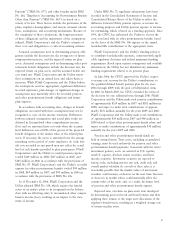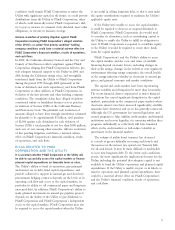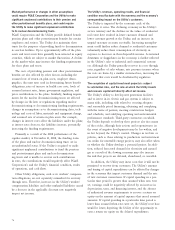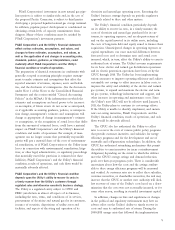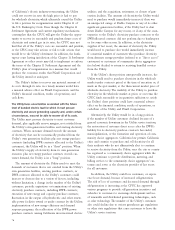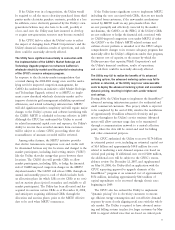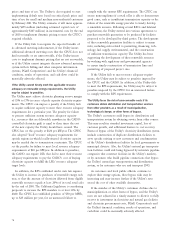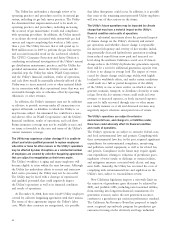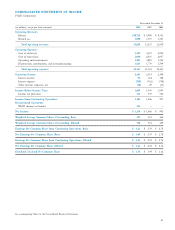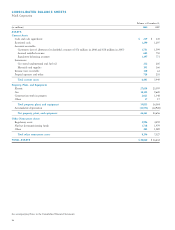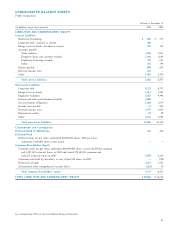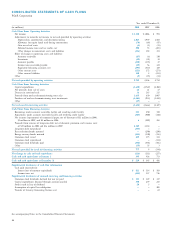PG&E 2008 Annual Report Download - page 78
Download and view the complete annual report
Please find page 78 of the 2008 PG&E annual report below. You can navigate through the pages in the report by either clicking on the pages listed below, or by using the keyword search tool below to find specific information within the annual report.76
utilities; and the acquisition, retirement, or closure of gen-
eration facilities. The amount of electricity the Utility would
need to purchase would immediately increase if there was
an unexpected outage at Diablo Canyon or any of its other
signifi cant generation facilities, if the Utility had to shut
down Diablo Canyon for any reason, or if any of the coun-
terparties to the Utility’s electricity purchase contracts or the
DWR-allocated contracts did not perform due to bankruptcy
or for some other reason. In addition, as the electricity
supplier of last resort, the amount of electricity the Utility
would need to purchase also would immediately increase
if a material number of customers who purchase electricity
from alternate energy providers (referred to as “direct access”
customers) or customers of community choice aggregators
(see below) decided to return to receiving bundled services
from the Utility.
If the Utility’s short position unexpectedly increases, the
Utility would need to purchase electricity in the wholesale
market under contracts priced at the time of execution or, if
made in the spot market, at the then-current market price of
wholesale electricity. The inability of the Utility to purchase
electricity in the wholesale market at prices or on terms the
CPUC fi nds reasonable or in quantities suffi cient to satisfy
the Utility’s short position could have a material adverse
effect on the fi nancial condition, results of operations, or
cash fl ows of the Utility and PG&E Corporation.
Alternatively, the Utility would be in a long position
if the number of Utility customers declined because of a
general economic downturn in the Utility service territory,
the restoration of customer direct access after the DWR’s
liability for its electricity purchase contracts has ended,
municipalization, or the formation and operation of com-
munity choice aggregators. California law permits California
cities and counties to purchase and sell electricity for all
their residents who do not affi rmatively elect to continue
to receive electricity from the Utility, once the city or county
has registered as a community choice aggregator while the
Utility continues to provide distribution, metering, and
billing services to the community choice aggregators’ cus-
tomers and serves as the electricity provider of last resort
for all customers.
In addition, the Utility could lose customers, or experi-
ence lesser demand, because of increased self-generation.
The risk of loss of customers and decreased demand through
self-generation is increasing as the CPUC has approved
various programs to provide self-generation incentives and
subsidies to customers to encourage development and use
of renewable and distributed generating technologies, such
as solar technology. The number of the Utility’s customers
also could decline due to stricter greenhouse gas regulations
or other state regulations that cause customers to leave the
Utility’s service territory.
of California’s electric industry restructuring, the Utility
could not recover in rates the high prices it had to pay
for wholesale electricity, which ultimately caused the Utility
to fi le a petition for reorganization under Chapter 11 of
the U.S. Bankruptcy Code. Even though the Chapter 11
Settlement Agreement and current regulatory mechanisms
contemplate that the CPUC will give the Utility the oppor-
tunity to recover its reasonable and prudent future costs of
electricity and natural gas in its rates, the CPUC may not
fi nd that all of the Utility’s costs are reasonable and prudent,
or the CPUC may take actions or fail to take actions that
would be to the Utility’s detriment. In addition, the bank-
ruptcy court having jurisdiction of the Chapter 11 Settlement
Agreement or other courts may fail to implement or enforce
the terms of the Chapter 11 Settlement Agreement and the
Utility’s plan of reorganization in a manner that would
produce the economic results that PG&E Corporation and
the Utility intend or anticipate.
The Utility’s failure to recover any material amount of
its costs through its rates in a timely manner would have
a material adverse effect on PG&E Corporation’s and the
Utility’s fi nancial condition, results of operations, and
cash fl ows.
The Utility faces uncertainties associated with the future
level of bundled electric load for which it must procure
electricity and secure generating capacity and, under certain
circumstances, may not be able to recover all of its costs.
The Utility must procure electricity to meet customer
demand, plus applicable reserve margins, not satisfi ed from
the Utility’s own generation facilities and existing electricity
contracts. When customer demand exceeds the amount
of electricity that can be economically produced from the
Utility’s own generation facilities plus net energy purchase
contracts (including DWR contracts allocated to the Utility’s
customers), the Utility will be in a “short” position. When
the Utility’s supply of electricity from its own generation
resources plus net energy purchase contracts exceeds cus-
tomer demand, the Utility is in a “long” position.
The amount of electricity the Utility needs to meet the
demands of customers that is not satisfi ed from the Utility’s
own generation facilities, existing purchase contracts, or
DWR contracts allocated to the Utility’s customers could
increase or decrease due to a variety of factors, including,
without limitation, a change in the number of the Utility’s
customers; periodic expirations or terminations of existing
electricity purchase contracts, including DWR contracts;
execution of new energy and capacity purchase contracts;
fl uctuation in the output of hydroelectric and other renew-
able power facilities owned or under contract by the Utility;
implementation of new energy effi ciency and demand
response programs; the reallocation of the DWR power
purchase contracts among California investor-owned electric



